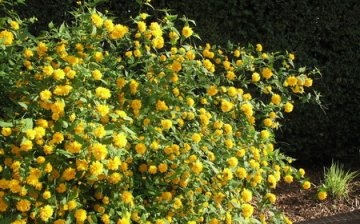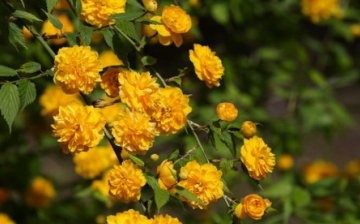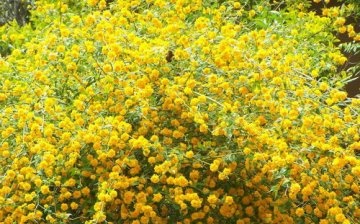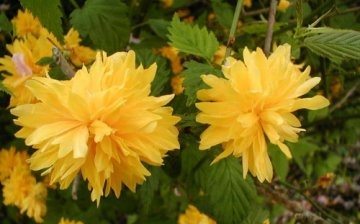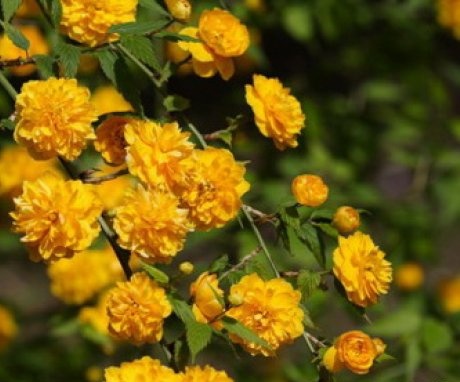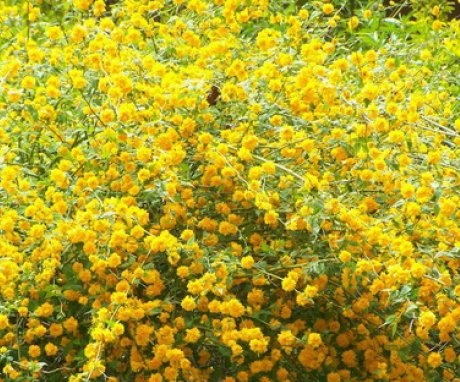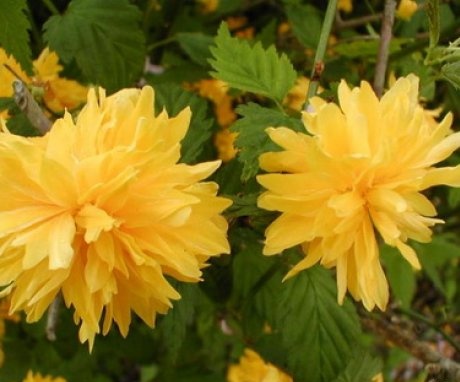Keria Japanese terry or Japanese rose
If you stop for a minute and look around you, you will notice what interesting plants surround us. Some of them surprise with their original foliage, others with bright colors, and still others with an excellent aroma. All these qualities are organically combined in the Japanese Keriya.
Content:
- What is Japanese Keriya
- Conditions for the blessed growth of the Japanese Keria
- How can a Japanese rose be propagated?
What is Japanese Keriya
This plant fascinates with its unusual appearance: flowing branches fall to the very ground, and bright yellow double flowers, like golden pompoms, cover the entire shrub. The flowering bush exudes a delicate and delicate aroma, and the flowers resemble small inflorescences roses... For this reason, the Japanese Keriya acquired another name - the Japanese rose.
Japanese terry keria came to us from Asian countries. It belongs to the Rosaceae family and belongs to deciduous shrubs. Under favorable climatic conditions, the plant forms a lush crown and can grow up to three meters in height.
The Japanese rose is characterized by good cold-resistance properties, it blooms in spring, as soon as the snow melts, the gentle rays of the sun warm up and the long-awaited warmth appears. The bare branches of the shrub are covered with numerous fluffy flowers, which reach 5-6 cm in diameter. The first abundant flowering ends quickly, but during the whole summer and until late autumn, single flowers form on the bush.
The decorativeness of the Japanese Keria is given not only by brightly colored flowers, but also by pointed oblong leaves, which grow up to 10 cm in length. In summer, they are light green in color, and in autumn they acquire a golden hue.
Conditions for the blessed growth of the Japanese Keria
Keria Japanese is well suited for both a sunny place and partial shade. If you are planting a shrub in full sun, provide it with adequate moisture. Under the influence of the bright sun, the flowering period is significantly reduced. The flowers of the Japanese rose fade and fade, so partial shade is still the most acceptable option.
Keria Japanese grows well on loose soils rich in humus. Ordinary land from a garden plot is fine. A planting hole is dug 60x60 cm in size and of sufficient depth so that the root system is not cramped. When planting, the soil is mixed with mineral fertilizers and humus. A bush is planted in this mixture, the soil is compacted and watered abundantly. Watering the plants are carried out throughout the growing season. The Japanese rose takes root well and grows abundantly.
The Japanese Keria bush produces multiple shoots, which lead to a strong growth of the bush - up to 2.5 meters. Therefore, it is recommended to carry out regular annual pruning of the plant. In spring, pruning should be minimal. Only dry and broken branches are removed, as well as some of the old branches along with the root. This will create favorable conditions for the growth of young shoots. They will provide autumn bloom this year and spring bloom next season.
A full pruning the bush is carried out after flowering in May or June. They shorten all branches and give the bush a beautiful shape.
If the location of the Japanese rose is well chosen, it will be able to overwinter without loss. But the plant is afraid of strong frosty winds.If in winter there is little snow and the snow cover is not deep, then the finally unformed shoots can freeze out.
Tying will help the plant overwinter. After autumn leaf fall, the branches of the bush are collected in a heap and tied. In this state, there is a chance that the plant will retain more living buds, which means that there will be more flowers on the bush in the spring.
If, nevertheless, the bush is damaged by frost, in the spring it quickly recovers, but bloom will no longer be abundant.
How can a Japanese rose be propagated?
Keria japonica reproduces in several ways. The most common breeding methods are:
- root shoots. The bush can be divided without digging out completely. The shoots with a part of the root are carefully separated from the bush and planted in the right place;
- young and lignified cuttings... Cuttings are cut in spring and summer and rooted in cool greenhouses. Rooted cuttings are planted in the ground in September-October before the onset of frost. For the winter, they must be covered with fallen leaves or straw. You can leave the cuttings in the greenhouse until spring, and in early spring you can plant them in the ground in a permanent place;
- horizontal layering. Flexible healthy branches are bent to the ground and fixed, well sprinkled with soil and thoroughly watered. The branches take root quickly and form a lush bush over time.
Due to its shade tolerance, Keriya Japanese looks good in the shady zone of the garden, where other plants will not bloom so abundantly. Growing in a shaded and humid place, Japanese Keriya is almost not exposed to diseases and is not afraid of pests. These qualities are rightfully appreciated by our gardeners and for this reason, Japanese rose bushes appear more and more often in the gardens.



